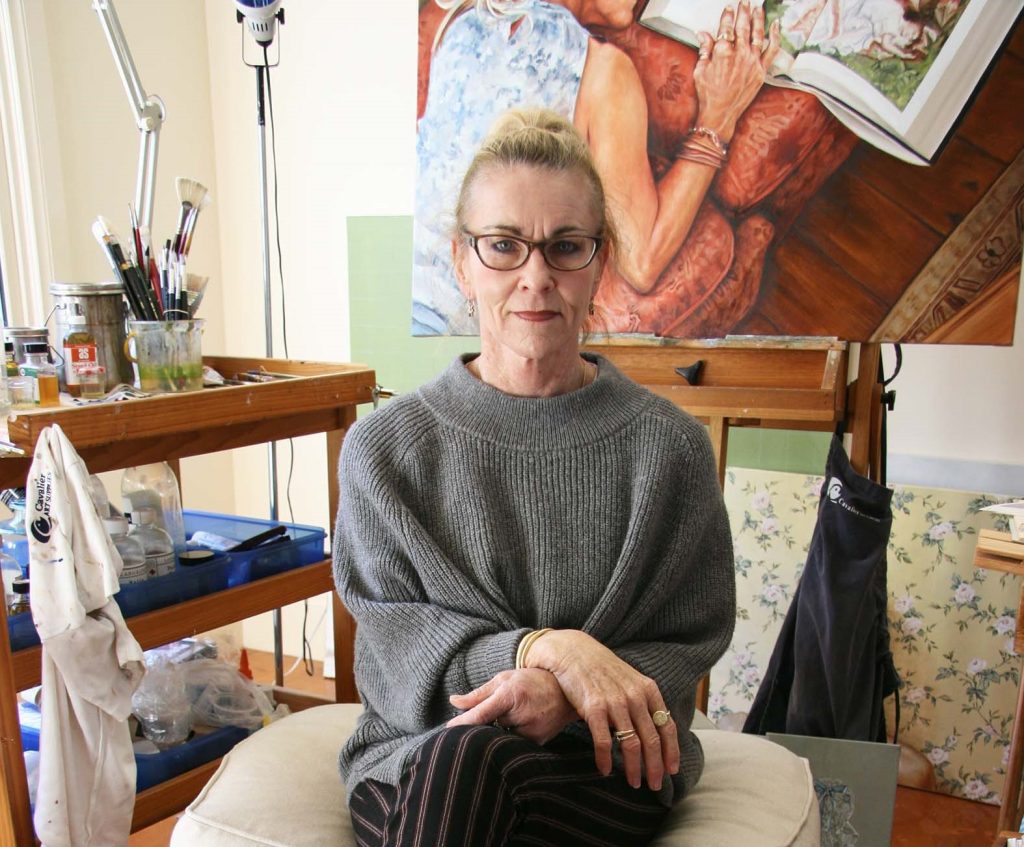Trudi Harley Painter - Melbourne, Australia
Don’t give up your dream to paint – Trudi Harley testifies to this, proving the need to paint exists. Harley paints with honesty and maturity, finding a safe harbour in her art.
Zoneone Arts brings Trudi Harley to you…
Your educational path has been long but very focused on the arts. Discuss how this has lead you to your current work practice.
I gained my Bachelor of Education Arts and Crafts in 1984 and taught in Government and Independent schools for 10 years after that. During this time I had a small hiatus in China where my husband had been stationed for work. I managed to collect a small gathering of expats from Hong Kong who employed my services as a portrait artist. I also spent some time in Sydney where I worked at Macquarie University in Administration. Though it sounds cliché I had a recurring dream where I envisaged I’d not finished my year 12 certificate, I read into this a failure to fulfil my potential in education.
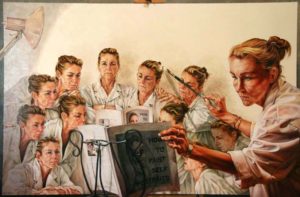
Self-Painting Selves –Oil on Canvas 152cmw x 102cmh, 2007
On my return from Sydney to Melbourne my marriage broke down and I started to question what my own needs were. I gained employment as a sales executive in an art supply company, ignoring for a while the pull toward extra knowledge I dabbled in my own artistic adventures. Entering in the Portia Geach Portrait Award in 2007 I was selected as a finalist and was also selected for their online gallery.
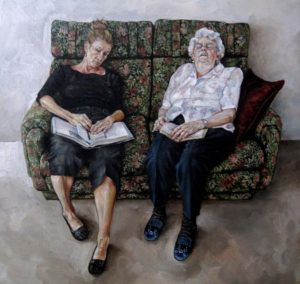
Becoming My Mother – Oil on Linen 30cmw x 30cmh, 2008
This gave me the encouragement I needed to return to University and in 2008 I enrolled in a Bachelor of Education Visual Arts Honours. The course allowed me to explore more fully my interests in the genre of portraiture. I drew on my experience as a teacher and used my knowledge of Art History which strongly influenced my work at this time.
After completing my Honours, I returned to University in 2010 and enrolled in a Master of Arts Visual Art – Research course. Here I explored my interpretations on the individuals understanding of reality and the importance of the inclusion of the mundane as a stabilising constant in everyday life.
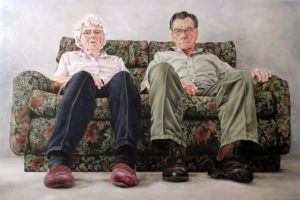
The Couple – Oil on Canvas 168cmw x 110cmh, 2008
You have a constant ‘thread’ in your work. Discuss how and why you paint objects that are on a thread.
The theme
Towards the end of my study in 2011 my father passed away. As I finished my research in 2012 I was drawn away from portraiture for a while as I looked for ways to immortalise my father’s memory. Initially I began to look at ways his life had influenced mine and what sort of connection we had established over the years. I had strong recollections of an object that he used in many of his construction tasks around the farm. The ‘Plumb Bob’ entered in to my repertoire of still life objects as it seemed both the ideal artistic motif and a symbol of my father as a constant and stabilising influence.
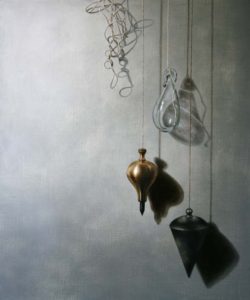
Reminiscence IV – Oil on Linen 50 x 60cm
Around this time, I came across the Spanish Bodegone Painters and more specifically the work of Juan Sanchez Cotan where I observed the practice of hanging foodstuffs from a string in order, to extend and preserve the life of the produce.
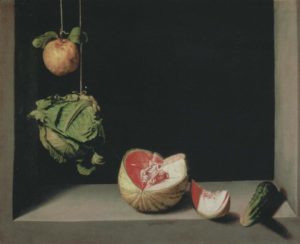
Juan Sanchez Cotan. Quince, Cabbage, Melon and Cucumber, 1602
Still Life by its very nature is based in the past. The ‘string’ or ‘thread’ in my work is a physical connection to those objects of my past and, as explained, is used as an analogy to extend and preserve those memories evoked by the object of which it holds. For an example ‘Reminiscence IV’ is specifically related to the memories I had of my father. Around this time I purchased a Plumb Bob, one which as closely as possible resembled the one my father owned (as I didn’t have the original). I also found a decorative glass ornament which in comparison of size and appearance looked very similar to the brass Plumb Bob I had obtained. However one was heavy, solid, strong, would survive if it fell to the ground, the other glass object was transparent, lightweight, and fragile and would smash if it fell. When you watch someone fight cancer you watch the strength drain out of them and they become a mere shell of what they once were.
The objects
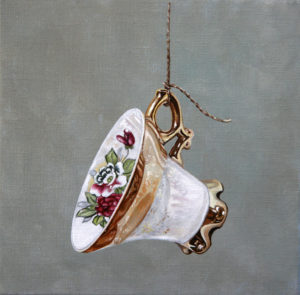
Cup XI – Oil on Linen 20cmw x 20cmh, 2017
The subject matter evolved, and I began to focus on happier interpretations. Growing up, the kitchen was considered one of the prime social gathering places of life on the farm, particularly afternoon tea. My father would often comment on the best cups to drink tea from, what made a good cup of tea, how hot it should be etc, etc.
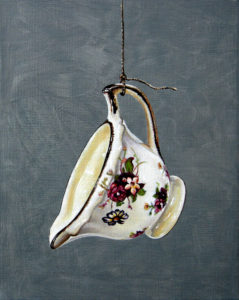
Milk Jug – Oil on Linen 20 x 25cm, 2017
Coming from a rural background I thought this sort of environment would have been reflected in many of the families of the time, I worked toward painting objects that would touch a broader audience and establish a sense of shared community with the viewer. Hence teacups, spoons, jugs, forks, knives, handkerchiefs – any object that we perhaps take for granted but in effect is an essential part of our everyday.
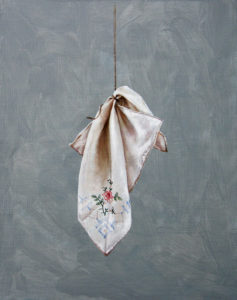
Handkerchief – Oil on Linen 20cm x 25cm, 2017
Comment on the difficulties of painting glass. As you are painting something that we can see through.
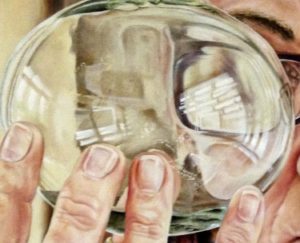
Through A Glass Bubble – Oil on Linen 35cmx 35cm, 2016
I’m not sure on the ‘difficulties’ of painting glass just as I’m not sure on the ‘difficulties’ of painting anything. I don’t mean to sound conceited but in my mind I tend not to paint a particular ‘thing’. I think the only time I tend to get into difficulty is of the object or thing that I am trying to paint so rather than concentrate on the glass I concentrate on the elements of the glass instead, i.e. the form or shape, the colour, the line, the tone etc and how these each relate to each other. By painting the smaller elements, the larger picture establishes itself.
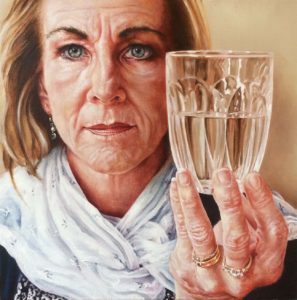
As You Like It – Oil on Linen 35cm x 35cm 2017
Then to a glass you have added a wilted rose, comment on the formatting of a still life.
I tend to play around with space as one of the main elements when constructing a painting. I look at the main elements of the picture and what I want to be the main centre of interest and where this should be placed in the picture frame in order to create the most acceptable layout. It is also necessary to work out where shadows fall and how this interplays with other objects within the arrangement. Where objects sit in the picture plane is one of the most important elements and to where your line of vision is drawn to – i.e. a shallow space created by moving the line of sight high on the picture frame or low to create more a more open space.
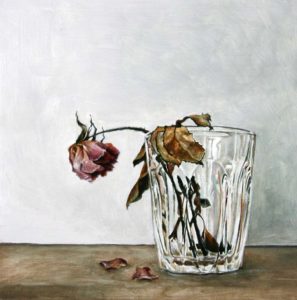
The Sick Rose – Oil on Wooden Panel, 20cmw x 20cmh, 2016
Your work ‘Fallen’ discuss this work from the conception to the final place where it is now held.
In my honours year I was looking into the theory of ‘esperpento’ and its interpretation in terms of my work. Esperpento (a description formulated by the Spanish Playwright Ramon del Valle-Inclan) is a Spanish word meaning ‘exaggeration’ or over emphasis often venturing into the grotesque, this may involve unusual viewpoints or the exaggeration of reality. As a theory I had been contemplating the significance of perceived expectations we may feel placed on ourselves by others and how this may affect the individual. I was examining ways to pictorially represent a failed sense of achievement, if perhaps we felt expectations had not been met. It is often advantageous to look at someone else’s life from another viewpoint or to look at a situation from another angle. I felt this work best emphasised the conclusion of my honours work, that often a fresh look at a problem from a different angle is beneficial and that judgement should be reserved until we have a full understanding of what we are dealing with.
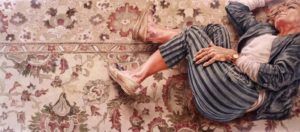
Fallen – Oil on Linen 152cm x 66cm, 2009
It was exhibited at the University of Ballarat’s Eye Exhibition and purchased by the University of Ballarat. The exhibition showcases works completed over the course of the year by the Camp Street Arts Precinct students.
Discuss the importance of self-portraiture.
Historically (how it has affected your work)
Your own work
I didn’t think about portraiture much until I went back to University, but I do recall buying a lot of art books when I was doing my Bachelor Degree. One artist that I took a particular liking to was Goya, I was very impressed with the fact that he didn’t flatter or embellish his sitters. I also liked the work of William Dobell and Amedeo Modigliani. They appeared to have an insight into their sitter and could convey this through the portrait rather than by just delivering a photographic likeness. Having said that I still like a realistic interpretation of the sitter but for me a portrait must tell some sort of story or convey more than just an image.
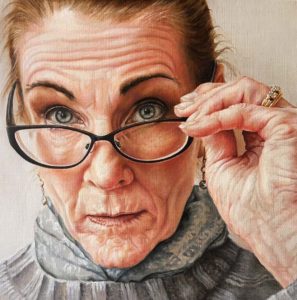
Self Portrait: With Glasses – Oil on Linen 35cmw x 35cmh, 2016
As to Self-Portraiture I was always a reliable sitter when I needed a subject. I was interested in my own journey as an artist and how this may be captured through the genre of portraiture. Self Portrait in a Convex Mirror typifies my process at the time. As explained I was looking at ‘esperpento’ and Portraiture and in my honours year and I was looking at the various ways artists had tackled this issue before. I recalled the work of Parmigianino and considered how a modern day take on his work might look. Where might you see your own image so distorted, under what circumstances would you see it and how would I make the work of Parmigianino relevant to my own in terms of his influence?
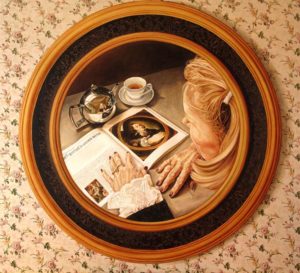
Self Portrait in Convex Surface – Oil on Canvas 112cmw x 112cmh, 2009
Many artists will not attempt hands. Expand on your painting of hands especially old hands.
I don’t see the point in steering away from something because you may not be good at it. If we are not constantly challenging ourselves and the way we think I’m not quite sure what the point of art is. I recall being given an exercise in year 8 or 9 at school which required us to go home and draw our hands and feet, though the exercise was difficult it opened up a whole new avenue of insight for me. It consolidated my thoughts on drawing what you can see and not what you know to be there. So many times we let the logic of our brain take over to depict what we think should be there rather than what we can physically observe. Yes, the many variances associated with hands do make them difficult to draw or paint if you allow them to. These two works were completed roughly around the same time. It was a comparison work to show the perceived passing of time. The first example was of my mother’s and her sister’s hands, the second was of my and my sister’s hands.
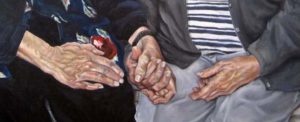
Hands 1 – Detail
Hands are the tools we use to ‘make’, ‘play’, ‘do’, ‘change’, ‘alter’ the very many tasks we complete each daily. As the daughter of a seamstress mother and woodworking father, I see our hands as our creative implements. Our age and our experience can be told through the appearance of our hands, so the older we become the more interesting the tools of our trade become.
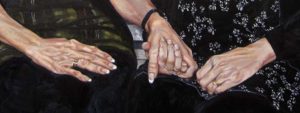
Hands 2 – Detail
You also use two mediums portraiture and still life how do you combine the two both artistically and how the object is part of the portrait.
When painting a portrait I often think about what the person does, not just for a living but in their everyday life, what is it about this person that needs to be ‘told’?. Here I would consider whether some form of object would best be included in a painting to challenge the observer to ask questions. It’s not merely enough to place something in a painting when it states the obvious, the audience needs to be engaged.
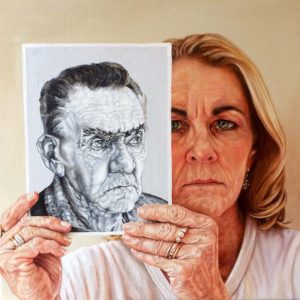
I Am My Father’s Daughter – Oil on Linen 35cm x 35cm, 2017
You often draw and paint the same object. Expand on how the same piece can change due to the medium you use.
When I look at people and objects I often envisage how I would go about painting or drawing them. There seems to be a particular aura that people and objects give off and I try to pick up on this. Finished works probably tend toward drawings or oil paintings as these two mediums are the ones I feel most comfortable with and most probably have the most control over.
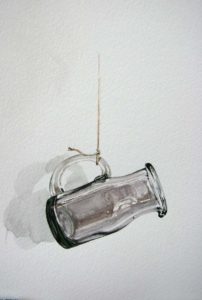
Glass Jug – Watercolour, 20cm x 25cm, 2018
I would consider asking myself several questions about the colouring of the subject matter, what needs to be included/subtracted in the work in order to convey the strongest message. However, I have recently introduced myself to the medium of watercolour and I am enjoying the fact that I don’t have as much control over the medium and that watercolour has an immediacy that is lacking in oil painting and in drawing.
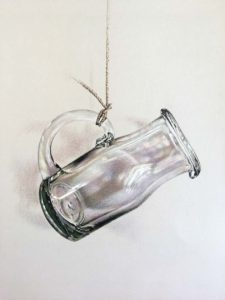
Glass Jug – Coloured Pencil 25cm x 30cm, 2018
Contact details:
Trudi Harley
Think a colleague or friend could benefit from this interview?
Knowledge is one of the biggest assets in any business. So why not forward this on to your friends and colleagues so they too can start taking advantage of the insightful information the artist has given?
Other artists you may be interested in:


